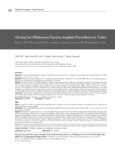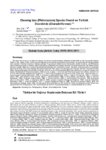|
|
Creator | Title | Description | Subject | Date |
| 1 |
 |
Sekercioglu, Cagan | Chewing lice (phthiraptera) found on songbirds (Passeriformes) in Turkey | Objective: This study was performed to detect chewing lice species found on the songbirds at Lake Kuyucuk bird ringing station in the Kars province located in eastern Turkey. Methods: Chewing lice were collected from songbirds captured between September and October 2009. Fifty-one birds belonging t... | | 2011-01-01 |
| 2 |
 |
Sekercioglu, Cagan | Chewing lice (phthiraptera) species found on birds along the Aras River, lgdir, Eastern Turkey | Chewing lice were sampled from the birds captured and ringed between September-October 2009 at the Aras River (Yukarı Çıyrıklı, Tuzluca, Iğdır) bird ringing station in eastern Turkey. Eighty-one bird specimens of 23 species were examined for lice infestation. All lice collected from the birds... | | 2011-01-01 |
| 3 |
 |
Beckerle, Mary C.; Clark, Kathleen A. | Integrin effector PINCH regulates JNK activity and epithelial migration in concert with Ras suppressor 1 | Cell adhesion and migration are dynamic pro- cesses requiring the coordinated action of multiple signaling pathways, but the mechanisms underlying signal integration have remained elusive. Drosophila embryonic dorsal closure (DC) requires both integrin function and c-Jun amino-terminal kinase (JNK) ... | Epithelial sheets; PINCH | 2004 |
| 4 |
 |
Clayton, Dale H. | Ecological basis of coevolutionary history | Macroevolutionary patterns are difficult to interpret because they are the product of a time scale so vast that deterministic and chance events are hard to distinguish. Although the macroevolutionary history of a group can be reconstructed from extant species, determining the ecological context in ... | | 2003 |
| 5 |
 |
Clayton, Dale H.; Rogers, Alan R. | Genetic analysis of lice supports direct contact between modern and archaic humans | Parasites can be used as unique markers to investigate host evolutionary history, independent of host data. Here we show that modern human head lice, Pediculus humanus, are composed of two ancient lineages, whose origin predates modern Homo sapiens by an order of magnitude (ca. 1.18 million years). | Pediculus humanus; Head lice; Molecular phylogeny; Phthirus | 2004 |
| 6 |
 |
Clayton, Dale H. | Biology, ecology, and evolution of chewing lice | Chewing lice are small, dorsoventrally compressed insects and are parasites of virtually all birds (Fig. 1) and some mammals (Fig. 2). Many chewing lice are host specific, being found on only a single species of host. All chewing lice are permanent ectoparasites and complete their entire life c... | Chewing lice | 2003 |
| 7 |
 |
Lawton, Kristy J. | Motor neurons tune premotor activity in a vertebrate central pattern generator | Central patterns generators (CPGs) are neural circuits that drive rhythmic motor output without sensory feedback. Vertebrate CPGs are generally believed to operate in a top-down manner in which premotor interneurons activate motor neurons that in turn drive muscles. In contrast, the frog (Xenopus la... | CPG; feed back; synchrony; vocal; vocalization; Xenopus | 2017 |
| 8 |
 |
Sekercioglu, Cagan | Chewing lice (Phthiraptera) species found on Turkish shorebirds (Charadriiformes) | Approximately 4.500 species of lice have been so far described, with about 4.000 species seen on birds and with 3.000 species in the suborder Ischnocera 1. There are 465 bird species so far recorded in Turkey and the actual total is likely to exceed 500 species. However, the chewing lice fauna of th... | | 2010-01-01 |
| 9 |
 |
Coley, Phyllis D.; Kursar, Thomas A. | Novel DNA-based microfluorimetric method to evaluate antimalarial drug activity | This paper describes the development of a novel microfluorimetric assay to measure the inhibition of Plasmodium falciparum based on the detection of parasitic DNA by intercalation with PicoGreen®. The method was used to determine parasite inhibition profiles and 50% inhibitory concentration values ... | Microfluorimetric assay; Plasmodium falciparum; Chloroquine; Drug discovery | 2004 |
| 10 |
 |
Clayton, Dale H. | Experimental test of the importance of preen oil in Rock Doves (Columba livia) | Most species of birds have a uropygial gland, also known as a preen gland, which produces oil that birds spread through their plumage when preening. The plumage of waterfowl deprived of uropygial oil becomes brittle and is subject to breakage. | Columba livia; Columbiformes; Preen oil; Ectoparasites; Columbicola columbae; Campanulotes compare; Plumage | 2003 |
| 11 |
 |
Adler, Frederick R. | Effect of 1918 PB1-F2 expression on influenza A virus infection kinetics | Relatively little is known about the viral factors contributing to the lethality of the 1918 pandemic, although its unparalleled virulence was likely due in part to the newly discovered PB1-F2 protein. This protein, while unnecessary for replication, increases apoptosis in monocytes, alters viral po... | | 2011 |
| 12 |
 |
Adler, Frederick R. | Effect of 1918 PB1-F2 expression on influenza A virus infection kinetics | Abstract Relatively little is known about the viral factors contributing to the lethality of the 1918 pandemic, although its unparalleled virulence was likely due in part to the newly discovered PB1-F2 protein. This protein, while unnecessary for replication, increases apoptosis in monocytes, alter... | | 2011 |
| 13 |
 |
Clayton, Dale H.; Bush, Sarah Elizabeth | Is melanin a defense against feather-feeding lice? | The adaptive basis of plumage color has received much attention, including the finding that color can reveal information about parasite loads to potential mates. A related possibility, that color may be a direct defense against parasites, has received less attention. | Columba livia; Columbiformes; Ectoparasites; Columbicola columbae; Campanulotes compare; Plumage color; Eumelanin; Preening | 2006 |
| 14 |
 |
Clayton, Dale H. | Ecoimmunity in Darwin's finches: invasive parasites trigger acquired immunity in the medium ground finch (Geospiza fortis) | Invasive parasites pose a serious threat to native animal populations, because hosts with no history of exposure may lack effective immune defenses. Invasive parasites are a particular threat to small, island populations [1,2]. For example, introduced malaria (Plasmodium relictum) has exacerbated t... | Darwins finches; Ecoimmunity; Acquired immunity; Medium ground finch; Geospiza fortis; Invasive parasites; Novel parasites; Poxvirus avium; Nest flies; Philornis downsi | 2010-01-06 |
| 15 |
 |
Olivera, Baldomero M. | Single amino acid substitutions in ĸ-conotoxin PVIIA disrupt interaction with the Shaker K+ channel | ĸ-Conotoxin PVIIA (ĸ-PVIIA), a 27-amino acid peptide with three disulfide cross-links, isolated from the venom of Conus purpurascens, is the first conopeptide shown to inhibit the Shaker K1 channel (Terlau, H., Shon, K., Grilley, M., Stocker, M., Stühmer, W., and Olivera, B. M. (1996) Nature ... | Conotoxins; k-conotoxin PVIIA; Shaker K+ channels; Conus purpurascens | 2000 |
| 16 |
 |
Coley, Phyllis D.; Kursar, Thomas A. | Using ecological criteria to design plant collection strategies for drug discovery | Tropical forests are one of the most diverse and endangered habitats on earth. They have also been portrayed as a source of future pharmaceuticals, yet finding useful compounds can be both scientifically and politically challenging. Increasingly, over the past decade, the potential value of medicina... | Drug discovery; Biodiversity | 2003 |
| 17 |
 |
Olivera, Baldomero M.; McIntosh, J. Michael | α-Conotoxin MII blocks nicotine-stimulated dopamine release in rat striatal synaptosomes | Activation of presynaptic nicotinic acetylcholine receptors (nAChRs) can induce the release of neurotransmitters such as dopamine and norepinephrine in the CNS. Accumulating evidence suggests that distinct nAChR subtypes are involved; however, it has been difficult to determine the subunit composit... | Conotoxins; a-Conotoxin MII | 1997 |
| 18 |
 |
Potts, Wayne K. | MHC signaling during social communication | The major histocompatibility complex (MHC) has been known to play a critical role in immune recognition since the 1950s. It was a surprise, then, in the 1970s when the first report appeared indicating MHC might also function in social signaling. Since this seminal discovery, MHC signaling has been f... | | 2012-01-01 |
| 19 |
 |
Bohs, Lynn A. | ITS phylogeny of Balsamorhiza and Wyethia (Asteraceae: Heliantheae) | The relationships among the species of Balsamorhiza and Wyethia (Asteraceae: Heliantheae) were examined using data from the internal transcribed spacer (ITS) region of the nuclear ribosomal DNA. The ITS sequences were obtained from nine species of Balsamorhiza and 14 species of Wyethia as well as se... | Asteraceae; Balsamorhiza; Heliantheae; Internal transcribed spacer; ITS; Molecular phylogeny; Wvethi | 2003 |
| 20 |
 |
Capecchi, Mario R. | Fundamental cellular processes do not require vertebrate-specific sequences within the TATA-binding protein. | The 180-amino acid core of the TATA-binding protein (TBPcore) is conserved from Archae bacteria to man. Vertebrate TBPs contain, in addition, a large and highly conserved N-terminal region that is not found in other phyla. We have generated a line of mice in which the tbp allele is replaced with a v... | Mice, Knockout; Cells, Cultured; Fibroblasts; Embryo | 2003-02-21 |
| 21 |
 |
Ehleringer, James R. | Carbon isotope ratios in belowground carbon cycle processes | Analyses of carbon isotope ratios (δ13C) in soil organic matter (SOM) and soil respired CO2 provide insights into dynamics of the carbon cycle. δ13C analyses do not provide direct measures of soil CO2 efflux rates but are useful as a constraint in carbon cycle models. In many cases, δ13C analyses... | Below ground processes; Ecosystems; Carbon cycle; Carbon isotope ratio; Ecosystem processes; Global change; Soil organic carbon; Soil organic matter | 2000 |
| 22 |
 |
Bohs, Lynn A. | Major clades in Solanum based on ndhF sequence data | Analysis of sequence data from the chloropiast gene ndhF identifies at least 12 major well-supported clades within the genus Solanum. These are briefly described, given informal clade names, and compared with the groups recognized by previous Solanum workers. Non-molecular synapomorphies are propos... | Solanum; ndhF | 2005 |
| 23 |
 |
Bohs, Lynn A. | Phylogenetic relationships in solanum section Androceras (Solanaceae) | The Leptostemonum clade of Solanum contains approximately 350-450 species, including the cultivated eggplant, S. melongena. This clade is characterized by the presence of prickles and apically attenuate anthers. Solanum section Androceras, the focus of this study, is a group of ca. 12 species belon... | | 2010-12-01 |
| 24 |
 |
Coley, Phyllis D. | Growth-defense trade-off and habitat specialization by plants in Amazonian forests | Tropical forests include a diversity of habitats, which has led to specialization in plants. Near Iquitos, in the Peruvian Amazon, nutrient-rich clay forests surround nutrient-poor white-sand forests, each harboring a unique composition of habitat specialist trees. We tested the hypothesis that t... | Amazon; Ecological gradient; Growth-defense trade-off; Habitat specialization; Herbivory; Phenolics; Phylogenetic control; Rainforest; Reciprocal-transplant experiment; Terpenes; Tropical trees | 2006 |
| 25 |
 |
Bohs, Lynn A. | Three-gene phylogeny of the genus Solanum (Solanaceae) | Solanum, with approximately 1,500 species, is the largest genus in the Solanaceae and includes economically important species such as the tomato, potato, and eggplant. In part due to its large size and tropical center of diversity, resolving evolutionary relationships across Solanum as a whole has ... | ndhF; trnT-F; Waxy; Solanum; Cyphomandra | 2007 |

























